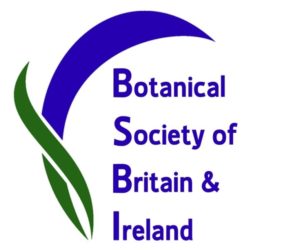Kirkcudbrightshire Botany Group at Newton Stewart, 29th April 2023
Our aim was to record the two monads NX 4364 and NX 4464, but thanks to Jim, who walked into the furthest and wettest part of the wood, we also recorded part of NX4463.
We started at the small car park off the Old Military Road above the wood and walked down the road through mixed scrub and woodland. Gorse Ulex europaeus was in full flower and there was a mixture of broadleaved trees including Beech Fagus sylvatica, together with conifers such as Scots Pine Pinus sylvestris and Sitka Spruce Picea sitchensis. We soon reached the area where the old lead miners’ cottages used to stand, now reduced to low stone walls. In this area were several garden plants, presumably the remnants of the miners’ occupation, but now naturalized on the verges of the road. These included Lily-of-the-valley Convallaria majalis, Garden Solomon’s-seal Polygonatum x hybridum, Garden Privet Ligustrum ovalifolium, Londonpride Saxifraga x urbium, Box Buxus sempervirens, Apple Malus domestica and even a very old bush of Sea-buckthorn Hippophae rhamnoides. This latter was close to an avenue of old beech trees leading over the brow of the hill, perhaps to a bigger house.
Opposite the cottages were old spoil heaps, still largely unvegetated, presumably due to the remaining toxicity. However, clumps of very short-stemmed Red Campion Silene dioica were flowering profusely here, somewhat surprisingly the only plant managing to cope with the conditions, and in flower much earlier than the Red Campion that we later found in the wood.
Our route then followed a path into Blackcraig Wood, a Scottish Wildlife Trust reserve. This is a broad-leaved woodland of Oak Quercus spp., Ash Fraxinus excelsior, Hazel Corylus avellana, Holly Ilex aquifolium and Rowan Sorbus aucuparia. The ground flora was dominated by Bluebell Hyacinthoides non-scripta (with several white flowers amongst the profusion of blue), together with Wood Sorrel Oxalis acetosella, Broad Buckler-fern Dryopteris dilatata and other Drypoteris ferns just unfurling, Hard-fern Blechnum spicant, Red Campion Silene dioica, Honeysuckle Lonicera periclymenum and Wood Sage Teucrium scorodonia.
Amongst the extensive areas of bluebells there were more localized species such as Dog’s Mercury Mercurialis perennis, Wood Anemone Anemone nemorosa, Climbing Corydalis Ceratocapnos claviculata and Enchanter’s-nightshade Circaea lutetiana. We saw no Red Squirrels Sciurus vulgaris, but neatly-halved hazelnuts were plentiful, which we assumed might be an indication of their presence. Thanks to Sue’s sharp eyes, we also came across a Dor Beetle on the path, which we identified as the Woodland Dor Beetle Anoplotrupes stercorosus.
Most of the group then retraced their steps to the car park, but Jim walked further into the wettest corner of the wood, adding a number of species to the list including Opposite-leaved Golden-saxifrage Chrysosplenium oppositifolium, Woodruff Galium odoratum, Sanicle Sanicula europaea, Ramsons Allium ursinum and Remote Sedge Carex remota. He also heard a Grasshopper Warbler Locustella naevia in the rushy field on the other side of the A75.
Ken recorded all birds seen and heard during the visit on BTO Bird Track, a total of 24 species, finishing with the first two swifts of the year over Jim’s house in Newton Stewart.
With thanks to all who took part, and especially Val who did a wonderful job completing the recording sheets.

